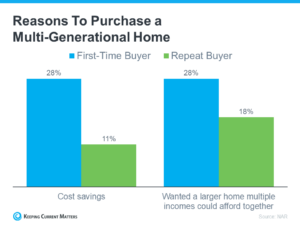Here’s Why You Should Consider Buying a Multigenerational Home
Unlike many other cultures around the world, Americans aren’t known for living multigenerationally. If 50 year-old Gary still lives with his mom, he’s a failure to launch. If Lisa’s mother-in-law moves in, it’s a burden to bear. The reality is, however, that we don’t always know the reasons why multiple generations live together, and they truly aren’t always negative. We could learn a thing or two about other cultures that live with multiple generations in the home, so here are some reasons why you might consider buying a multigenerational home.
Emotional Benefits
Although most people put on record that they choose multigenerational living for cost savings/sharing or caregiving, Pew Research tells us that many people cite the emotional bond that can come from living with family.

Pew also tells us that multigenerational living has increased in the past 50 years and hasn’t seemed to peak yet. While a quarter of the people they surveyed said that multigenerational living is stressful most of the time, more than twice that number said “it is mostly or always rewarding.”
Unless you’re an extreme introvert, the perks of having a built-in community is an extremely high emotional benefit. There’s always someone to talk to (intellectual stimulation), you don’t have to feel lonely, you can create shared and memorable experiences through making meals, baking, hosting parties, etc. As long as people in the home respect each other’s privacy and provide individual spaces for retreat, this can be a win-win for everyone’s emotional and mental health.
Financial Benefits
This seems to be a clear perk and possibly number one motivator for buying a multigenerational home. Keeping Matters Current tells us, “By pooling their resources, households can share the financial responsibilities like mortgage payments, utilities, property taxes, and maintenance, to make homeownership more affordable. This is especially helpful for first-time homebuyers who may be finding it tough to afford a home on their own in today’s market.”
Think about the housing possibilities that can open up when pooling together multiple incomes. The quality and size of home can increase OR, if that isn’t a priority, you could live mortgage free or with low cost to home expenses.

Graphic resource: Keeping Matters Current
In addition, this type of living can open up opportunities for one of the residents to pay down debt while the other takes on the bulk of the expenses. It could also provide a safer and more affordable (potentially free) childcare environment.
There are many scenarios we could pose that show the financial benefit to multigenerational living, but just put yourself in the example, and you’ll see it.
How Does it Work?
So, you’re convinced that buying a multigenerational home is what’s right for you and your family – what’s the best approach?
The first thing to know is that finding a multigenerational home setup isn’t as easy as your average residential home search. There are multiple wish lists and needs to consider, and potentially, multiple living spaces. Whether it’s land with a guest house, a home with a walk-out basement or mother-in-law quarters, your options will be more limited and unique. This is not a feat too big for a good real estate agent. (Check out these tips on choosing the right real estate agent.)
Secondly, this actually opens up your financial and loan options. If one buyer has better credit or more access to capital, perhaps it’s best to buy the home in that buyer’s name and let the other resident take over utilities and grocery expenses. There are ways to even out the costs while keeping everyone in the best financial position.
At Dani Beyer Real Estate, it wouldn’t be our first rodeo helping with a multigenerational living situation. We know the market, we know the city, and we can help find the best home to fit all the needs of your beautifully diverse family.
